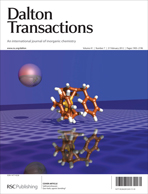Stabilising pentavalent actinides—visible–near infrared and X-ray absorption spectroscopic studies of the utility of the [(Np3W4O15)(H2O)3(MW9O33)3]18− (M = Sb, Bi) structural type†
Abstract
We report the interaction between B-type tri-lacunary heteropolyoxotungstate anions and actinyl(V) ![[triple bond, length as m-dash]](https://www.rsc.org/images/entities/char_e002.gif) An
An![[triple bond, length as m-dash]](https://www.rsc.org/images/entities/char_e002.gif) O1+ linear dioxo actinide moiety. Previously we reported that B-α-[BiW9O33]9− and B-α-[SbW9O33]9− will react with NpO21+ to yield [(Np3W4O15)(H2O)3(MW9O33)3]18− (M = Bi, or Sb). Single crystal structural characterisation of salts of these complexes revealed a core in which three NpV atoms interact with a central WVI atom through bridging oxo groups. These bridging oxygen atoms come from one of the two axial oxygens in O
O1+ linear dioxo actinide moiety. Previously we reported that B-α-[BiW9O33]9− and B-α-[SbW9O33]9− will react with NpO21+ to yield [(Np3W4O15)(H2O)3(MW9O33)3]18− (M = Bi, or Sb). Single crystal structural characterisation of salts of these complexes revealed a core in which three NpV atoms interact with a central WVI atom through bridging oxo groups. These bridging oxygen atoms come from one of the two axial oxygens in O![[triple bond, length as m-dash]](https://www.rsc.org/images/entities/char_e002.gif) Np
Np![[triple bond, length as m-dash]](https://www.rsc.org/images/entities/char_e002.gif) O1+ and represent a highly unusual interaction for a discrete molecular species. In this study visible/near infra-red
O1+ and represent a highly unusual interaction for a discrete molecular species. In this study visible/near infra-red
![Graphical abstract: Stabilising pentavalent actinides—visible–near infrared and X-ray absorption spectroscopic studies of the utility of the [(Np3W4O15)(H2O)3(MW9O33)3]18− (M = Sb, Bi) structural type](/en/Image/Get?imageInfo.ImageType=GA&imageInfo.ImageIdentifier.ManuscriptID=C1DT11742D&imageInfo.ImageIdentifier.Year=2012)

 Please wait while we load your content...
Please wait while we load your content...